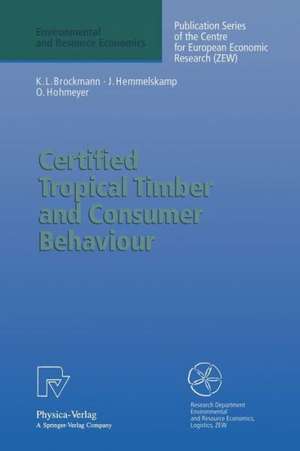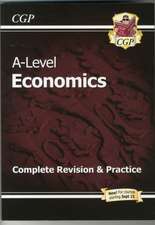Certified Tropical Timber and Consumer Behaviour: The Impact of a Certification Scheme for Tropical Timber from Sustainable Forest Management on German Demand: Environmental and Resource Economics
Autor Karl L. Brockmann, Jens Hemmelskamp, Olav Hohmeyeren Limba Engleză Paperback – 10 iul 1996
Preț: 382.36 lei
Nou
Puncte Express: 574
Preț estimativ în valută:
73.17€ • 78.24$ • 61.00£
73.17€ • 78.24$ • 61.00£
Carte tipărită la comandă
Livrare economică 18 aprilie-02 mai
Preluare comenzi: 021 569.72.76
Specificații
ISBN-13: 9783790809558
ISBN-10: 3790809551
Pagini: 196
Ilustrații: XVI, 178 p. 5 illus.
Dimensiuni: 155 x 235 x 10 mm
Greutate: 0.28 kg
Ediția:1996
Editura: Physica-Verlag HD
Colecția Physica
Seria Environmental and Resource Economics
Locul publicării:Heidelberg, Germany
ISBN-10: 3790809551
Pagini: 196
Ilustrații: XVI, 178 p. 5 illus.
Dimensiuni: 155 x 235 x 10 mm
Greutate: 0.28 kg
Ediția:1996
Editura: Physica-Verlag HD
Colecția Physica
Seria Environmental and Resource Economics
Locul publicării:Heidelberg, Germany
Public țintă
ResearchCuprins
1 Introduction.- I: General Conditions for Tropical Timber Certification.- 2 Concepts of Sustainability and the Design of a Certification Scheme for Tropical Timber.- 3 Effectiveness and Efficiency of a Certification Scheme Aimed at Protecting Tropical Rain Forests.- 4 Certification and Tropical Timber Supply.- 5 Environmental Labels and Consumer Behaviour.- II: Basic Scenarios for a Certified Tropical Timber Market in the Federal Republic of Germany.- 6 Definitions, Database and Data Processing.- 7 Distribution of Tropical Timber in the Federal Republic of Germany.- 8 Trend Analysis and Basic Scenarios.- III: Extended Scenarios for a Certified Tropical Timber Market under Different Supply and Demand Constellations.- 9 Theoretical Foundations.- 10 Extended Scenarios for Individual Submarkets.- 11 Extended Scenarios of the Aggregate Timber Market.- 12 Conclusions.- A1 Procedure for Evaluating the Foreign Trade Statistics.- A2 Production Quantities and Values of Lacquer of German Production.- A3 List of Goods Categories in the Foreign Trade Statistics as Information Source for Tropical Timber.- A4 Net Imports of Tropical Timber into the Federal Republic of Germany.- A5 Conversion Factors for Evaluating the Foreign Trade Statistics.- A6 Recovery Rates.- A7 Domestic Final Consumption of Tropical Timber in the Federal Republic of Germany in 1984.- A8 Half-Finished Tropical Timber Products: Chief Uses and Substitutes.- A9 Finished Timber Products on the German Market Containing No or Negligible Tropical Timber from Natural Forests.- A10 Graphic Depiction of a Contracting or Expanding Demand.- A11 Determining the Reaction Directions of the Derived Demand.- Summary.
Textul de pe ultima copertă
Boycotting tropical timber reduces its economic value and provides an incentive to burn down forests, making them available for subsequent agricultural use or livestock farming. In contrast, a certification scheme for sustainability produced timber (tropical or non-tropical) protects the forests by raising their economic value.
This study examines the impact of a certification scheme on German demand for tropical timber. A partial-equilibrium model is developed for the German tropical timber market as a whole as well as for five important submarkets representing 50% of the total demand. The results reveal that a credible certification scheme can induce a significant expansion of demand for sustainability produced tropical timber. This holds true for a scheme restricted to Germany as well as for an OECD-wide approach.
This study examines the impact of a certification scheme on German demand for tropical timber. A partial-equilibrium model is developed for the German tropical timber market as a whole as well as for five important submarkets representing 50% of the total demand. The results reveal that a credible certification scheme can induce a significant expansion of demand for sustainability produced tropical timber. This holds true for a scheme restricted to Germany as well as for an OECD-wide approach.








